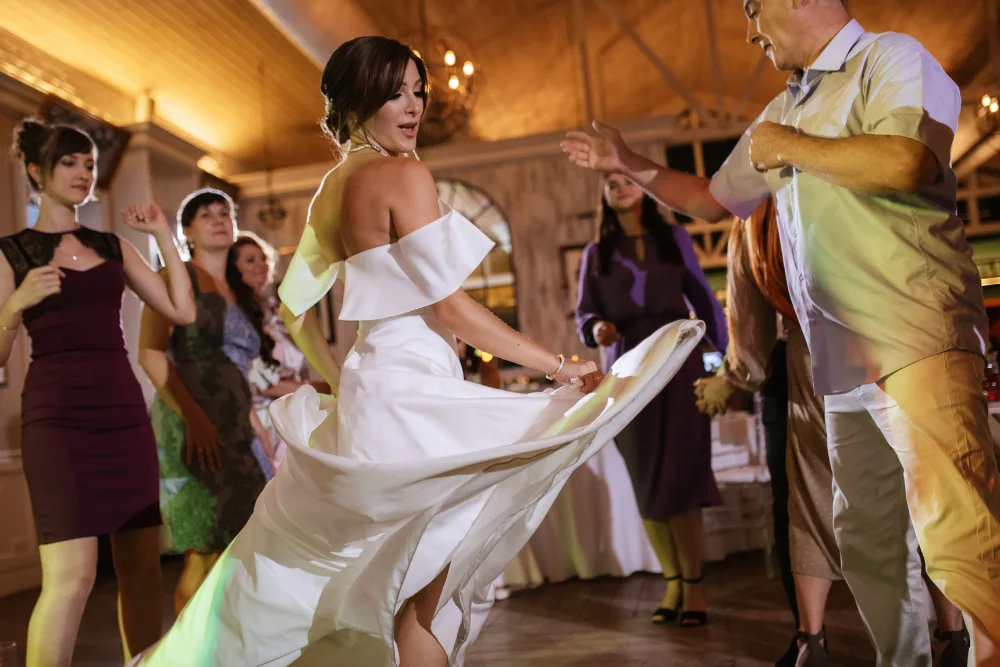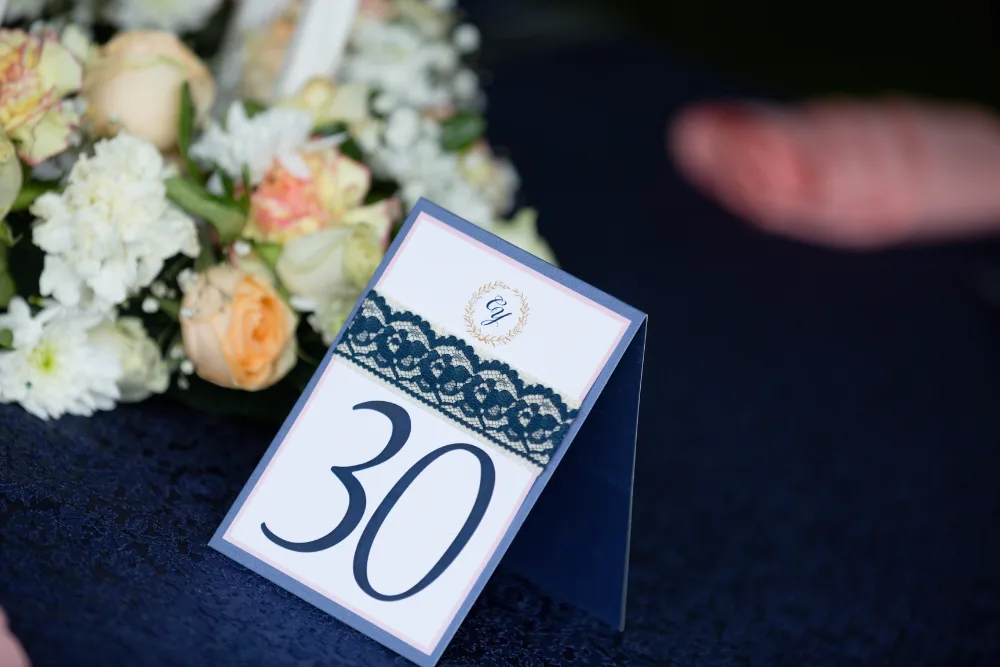Why Timing Makes or Breaks a Stress-Free Wedding
Every couple dreams of a wedding that feels smooth, organized, and joyful from start to finish. But if you talk to anyone who’s been through it, they’ll tell you, even the smallest delay can throw off the entire day.
Hair and makeup run late. A family photo takes longer than planned. Guests wander to the bar instead of their seats. These tiny hiccups pile up fast.
So, what is the 30-5 minute rule for weddings? It’s a simple yet powerful approach to wedding day timing: add a 30-minute buffer for major events, build a 5-minute buffer for small transitions, and be ready five minutes early for the big moments.
This method helps your timeline stay realistic while giving you space to breathe. You’ll stay calm, your guests won’t feel rushed, and every part of the day will unfold naturally.
How to Apply the 30-5 Minute Rule in Your Wedding Timeline Planning
Knowing the rule is one thing, but applying it correctly is what makes the difference. Here’s how to weave the 30-5 method into your wedding timeline planning step by step:
Step 1: Start with Your Core Events
List the anchors of your day: ceremony, cocktail hour, dinner, and reception. These are the foundation of your timeline. Once those are fixed, you’ll fill in the rest.
Step 2: Apply the 30-Minute Buffers
Add thirty minutes to each of your main segments. These adjustments build room for real life without making your day drag. For example:
- Ceremony: 30 min → 1 hour
- Dinner and speeches: 60 min → 90 min
- Photography session: 45 min → 75 min
Step 3: Add Five-Minute Gaps for Transitions
For every movement, from ceremony to photos, photos to reception, and dinner to dancing, include a 5-minute transition. It’s the breathing room between one emotion and the next.
Step 4: Mark “Ready Five Minutes Early” Goals
Circle key times like your ceremony or grand entrance and write “ready five minutes early.” It’s a small shift that creates mental calm.
Step 5: Share the Final Version
Send the completed timeline to your planner, vendors, and wedding party. Everyone should know the adjusted schedule so that all moving parts, from catering to photography, stay in sync.
If you’re working with an all-inclusive wedding venue, this step becomes even easier. Because the venue provides most essential services, such as catering, décor, lighting, and coordination, you don’t need to juggle multiple outside vendors. The on-site team handles timing internally, keeping every part of your celebration aligned and stress-free.
When your venue manages everything under one roof, your timeline runs smoothly from the first toast to the last dance. By applying these steps, you turn your schedule from a checklist into a well-paced experience that lets you focus on what truly matters: enjoying your wedding day.
For a deeper breakdown of how to organize each part of your day, you can also reference Zola’s wedding planning guide on creating a timeline. It’s a great visual resource to help you see how professional planners structure a full wedding day.

Why the 30-5 Minute Rule Works So Well
Every wedding has countless moving parts: hair and makeup, first looks, photos, toasts, meals, and music. When any of these moments run late, the entire timeline can shift. The 30-5 approach prevents that domino effect.
Here’s why it’s one of the best tips for stress-free wedding planning:
- Reduces stress: One small delay won’t ruin your schedule.
- Creates flexibility: Gives you breathing room for emotions and unexpected pauses.
- Improves vendor coordination: Everyone can stay aligned without rushing.
- Keeps guests comfortable: Smooth transitions keep energy flowing naturally.
The goal isn’t perfection; it’s balance. The 30-5 rule gives your timeline rhythm and calm. This small structure helps your brain stay calm. You’ll never feel like you’re chasing the clock, and your guests will feel that same ease, too.
Couples who use the 30-5 minute rule wedding often say their celebration felt longer, more relaxed, and more emotionally memorable.
Sample Wedding Timeline Using the 30 5 Minute Rule
A great wedding timeline is not about doing more, it’s about giving each moment space to happen. Here’s what a full-day schedule looks like with the 30-5 system applied:
- 9:00 a.m. Hair and makeup begin
- 9:45 a.m. Attire and finishing touches (+30 minutes buffer)
- 10:15 a.m. Transition to first look setup (+5 minutes)
- 10:20 a.m. First look and couple portraits
- 10:55 a.m. Family photos (+30 minutes buffer)
- 11:25 a.m. Travel to ceremony venue
- 11:55 a.m. Guests begin arriving
- 12:25 p.m. Ceremony begins (+30 minutes buffer)
- 1:10 p.m. Recessional and greetings (+5 minutes)
- 1:15 p.m. Cocktail hour
- 1:45 p.m. Reception introductions
- 2:15 p.m. Dinner service (+30 minutes buffer)
- 2:55 p.m. Toasts and speeches
- 3:25 p.m. First dances
- 3:55 p.m. Cake cutting (+5 minutes)
- 4:00 p.m. Open dance floor
- 7:00 p.m. Couple send-off
This flow keeps your day intentional, unhurried, and enjoyable — exactly how it should feel.

Tips for a Smooth and Stress-Free Wedding
To make the most of your stress-free wedding planning, combine the 30-5 method with these easy habits:
- Use one master schedule. Share it with your bridal party, vendors, and venue.
- Start earlier than you think. Morning prep often takes longer than planned.
- Have your photos done early. It frees you to enjoy cocktail hour with guests.
- Rely on your venue team. Venues like Metropol Event Venue in Los Angeles coordinate every timeline detail, from catering to lighting cues, so you stay focused on the celebration.
- Plan your exit. Ending the night on time keeps guests energized and happy.
When structure and support meet, your event feels effortless.
How Metropol Makes Perfect Timing Possible
At Metropol, we’ve built our reputation on helping couples celebrate smoothly and joyfully. Our in-house planning team uses proven techniques like the 30-5 minute rule for weddings to keep every moment running beautifully.
Our kitchen, lighting crew, and service staff all communicate in real time to match the pace of your event. Meals are served on schedule, transitions happen seamlessly, and every cue, from music to toasts, follows a natural rhythm.
With multiple ballrooms, on-site catering, and full coordination, Metropol is designed for couples who want structure without stress. From the moment you arrive until your grand exit, everything moves according to your ideal timing.
Book a tour at Metropol Event Venue in Los Angeles and see how simple planning can feel when professionals manage your timeline from start to finish.

The Beauty of Breathing Room
Understanding what is the 30-5 minute rule for weddings can change the way you plan your day. It’s a small shift that turns chaos into calm, structure into flow, and a packed schedule into an enjoyable experience.
When your timing feels right, your memories feel richer. And that’s exactly what every wedding should be about: time spent celebrating, not stressing.
Frequently Asked Questions About the 30-5 Minute Rule for Weddings
How early should I begin my wedding timeline planning?
Start at least six months before your date. Begin by blocking major segments: ceremony, cocktail hour, reception, and then apply the 30-5 rule to add comfort and flow.
Can the 30-5 minute rule wedding concept work for smaller weddings or elopements?
Yes. Even intimate gatherings benefit from structure. Short events still feel smoother when there’s breathing room between transitions.
What if one part of the wedding runs late? Does this rule still help?
That’s exactly why it works. Those five-minute gaps protect your schedule. Small delays won’t affect meals, music, or your grand entrance.
Should vendors know about the 30-5 minute rule?
Absolutely. Your photographer, caterer, and DJ should all follow the same timeline. When everyone works from one plan, your day flows effortlessly.
How do I know if my timeline is realistic?
A good test is to walk through your day mentally and imagine how people will actually move, talk, and react. If any part feels rushed or tight, it probably is. Apply the 30-5 rule to those sections , add a 30-minute cushion for key moments and five-minute gaps for transitions, until it feels comfortable and natural.
